Production and Properties of FeB-Fe2B-Fe3(B,C) Surface Layers Formed on Tool Steel Using Combination of Diffusion and Laser Processing
Abstract
:1. Introduction
2. Materials and Methods
3. Results and Discussion
3.1. Microstructure, Phase, and Chemical Composition
3.2. Microhardness Profiles
3.3. Corrosion Resistance
3.4. Wear Resistance
4. Conclusions
Funding
Conflicts of Interest
References
- Steen, W.M.; Mazumder, J. Laser Material Processing, 4th ed.; Springer: London, UK, 2010. [Google Scholar] [CrossRef]
- Hajkowski, J.; Popielarski, P.; Ignaszak, Z. Cellular automaton finite element method applied for microstructure prediction of aluminium casting treated by laser beam. Arch. Foundry Eng. 2019, 19, 111–118. Available online: http://journals.pan.pl/Content/113135/PDF/AFE+3_2019_19.pdf?handler=pdf (accessed on 23 October 2020).
- Wojciechowski, S.; Przestacki, D.; Chwalczuk, T. The evaluation of surface integrity during machining of Inconel 718 with various laser assistance strategies. MATEC Web Conf. 2017, 136, 01006. [Google Scholar] [CrossRef] [Green Version]
- Przestacki, D.; Kukliński, M.; Bartkowska, A. Influence of laser heat treatment on microstructure and properties of surface layer of Waspaloy aimed for laser assisted machining. Int. J. Adv. Manuf. Technol. 2017, 93, 3111–3123. [Google Scholar] [CrossRef]
- Gunes, I.; Kayali, Y. Investigation of mechanical properties of borided nickel 201 alloy. Mater Des 2014, 53, 577–580. [Google Scholar] [CrossRef]
- Ueda, N.; Mizukoshi, T.; Demizu, K.; Sone, T.; Ikenaga, A.; Kawamoto, M. Boriding of nickel by the powder pack method. Surf. Coat. Technol. 2000, 126, 25–30. [Google Scholar] [CrossRef]
- Pertek, A.; Kulka, M. Characterization of single tracks after laser surface modification of borided 41Cr4 steel. Appl. Surf. Sci. 2003, 205, 137–142. [Google Scholar] [CrossRef]
- Bartkowska, A.; Swadźba, R.; Popławski, M.; Bartkowski, D. Microstructure, microhardness, phase analysis and chemical composition of laser remelted FeB-Fe2B surface layers produced on Vanadis-6 steel. Opt. Laser Technol. 2016, 86, 115–125. [Google Scholar] [CrossRef]
- Krukovich, M.G.; Prusakov, B.A.; Sizov, I.G. Plasticity of Boronized Layers; Springer Series in Materials Science; Springer International Publishing: Berlin/Heidelberg, Switzerland, 2016; p. 237. ISBN 978-3-319-40012-9. (eBook). [Google Scholar] [CrossRef]
- Czerwinski, F. (Ed.) Thermochemical Treatment of Metals. In Heat Treatment—Conventional and Novel Applications; IntechOpen: London, UK, 2012; Chapter 5. [Google Scholar] [CrossRef] [Green Version]
- Taazim, N.T.; Jauhari, I.; Miyashita, Y.; Sabri, M.F.M. Development and kinetics of TiB2 layers on the surface of titanium alloy by superplastic boronizing. Metall. Mater. Trans. A 2016, 47, 2217–2222. [Google Scholar] [CrossRef]
- Bartkowski, D.; Bartkowska, A.; Popławski, M.; Przestacki, D. Microstructure, microhardness, corrosion and wear resistance of B, Si and B-Si coatings produced on C45 steel using laser processing. Metals 2020, 10, 792. [Google Scholar] [CrossRef]
- Bartkowski, D.; Bartkowska, A.; Piasecki, A.; Jurči, P. Influence of laser cladding parameters on microstructure, microhardness, chemical composition, wear and corrosion resistance of Fe–B composite coatings reinforced with B4C and Si particles. Coatings 2020, 10, 809. [Google Scholar] [CrossRef]
- Bartkowska, A.; Bartkowski, D.; Popławski, M.; Piasecki, A.; Przestacki, D.; Miklaszewski, A. Microstructure, microhardness, corrosion resistance and chemical composition of Mo, B and Mo-B coatings produced using laser processing. Materials 2020, 13, 3249. [Google Scholar] [CrossRef]
- Bartkowski, D.; Matysiak, W.; Wojtko, K. Stellite-6 surface layers reinforced with hard and refractory WC particles produced on steel for metal forming. IOP Conf. Ser. Mater. Sci. Eng. 2018, 393, 012093. [Google Scholar] [CrossRef]
- Rajput, D.; Lansford, K.; Costa, L.; Hofmeister, W. Molybdenum-on-chromium dual coating on steel. Surf. Coat. Technol. 2009, 203, 1281–1287. [Google Scholar] [CrossRef]
- Khedkar, J.; Khanna, A.S.; Gupt, K.M. Tribological behaviour of plasma and laser coated steels. Wear 1997, 205, 220–227. [Google Scholar] [CrossRef]
- Qin, L.; Yang, K.; Liu, C.; Tang, B. Enhanced plasma boriding with molybdenum using double glow plasma surface alloying technique. Mater. Lett. 2012, 82, 127–129. [Google Scholar] [CrossRef]
- Bartkowska, A.; Pertek, A. Laser production of B–Ni complex layers. Surf. Coat. Technol. 2014, 248, 23–29. [Google Scholar] [CrossRef]
- Safonov, A.N. Special features of boronizing iron and steel using a continuous wave CO2 laser. Metal Sci. Heat Treat. 1998, 40, 6–10. Available online: https://link.springer.com/article/10.1007/BF02468497 (accessed on 23 October 2020). [CrossRef]
- Morimoto, J.; Ozaki, T.; Kubohori, T.; Morimoto, S.; Abe, N.; Tsukamoto, M. Some properties of boronized layers on steels with direct diode laser. Vacuum 2009, 83, 185–189. [Google Scholar] [CrossRef]
- Kusiński, J. Lasers and Their Application in Materials Engineering; Akapit: Cracow, Poland, 2000. (In Polish) [Google Scholar]
- Dobrzański, L.A.; Jonda, E.; Labisz, K.; Bonek, M.; Klimpel, A. The comparision of tribological properties of the surface layer of the hot work tool steels obtained by laser alloying. JAMME 2010, 42, 142–147. [Google Scholar]
- Major, B. Laser modification of steel by introducing carbides and borides. 3rd Polish National Conference Surface Treatment. Conf. Mater. 1996, 263–269. [Google Scholar]
- Wiśniewski, K.; Pertek, A. Influence of laser alloying with amorphous boron on structure and microhardness of 41Cr4. Arch Metall Mater 2009, 54, 111–114. [Google Scholar]
- Sashank, S.; Babu, P.D.; Marimuthu, P. Experimental studies of laser borided low alloy steel and optimization of parameters using response surface methodology. Surf. Coat. Technol. 2019, 363, 255–264. [Google Scholar] [CrossRef]
- Nath, A.; Sarkar, S. Laser transformation hardening of steel. In Advances in Laser Materials Processing, 2nd ed.; Woodhead Publishing: Sawston, UK; Cambridge, UK, 2018; Chapter 11; pp. 257–298. [Google Scholar] [CrossRef]
- Moradi, M.; Arabi, H.; Moghadam, M.K.; Benyounis, K.Y. Enhancement of surface hardness and metallurgical properties of AISI 410 by laser hardening process; diode and Nd: YAG lasers. Optik 2019, 188, 277–286. [Google Scholar] [CrossRef]
- Karmakar, D.P.; Gopinath, M.; Nath, A.K. Effect of tempering on laser remelted AISI H13 tool steel. Surf. Coat. Technol. 2019, 361, 136–149. [Google Scholar] [CrossRef]
- Bartkowski, D.; Matysiak, W.; Bartkowska, A. Selected properties of laser cladding coatings shaped using Flowdrill technology. MATEC Web Conf. 2017, 137, 05001. [Google Scholar] [CrossRef] [Green Version]
- Matysiak, W.; Bartkowski, D.; Frąckowiak, P. Microstructure, microhardness and general characterization of sintered tools using for flanging of hole edge by Flowdrill technology. IOP Conf. Series Mater. Sci. Eng. 2018, 393, 012094. [Google Scholar] [CrossRef]
- Lou, D.C.; Akselsen, O.M.; Onsøien, M.I.; Solberg, J.K.; Berget, J. Surface modification of steel and cast iron to improve corrosion resistance in molten aluminium. Surf. Coat. Technol. 2006, 200, 5282–5288. [Google Scholar] [CrossRef]
- Davis, J.R. Surface Engineering for Corrosion and Wear Resistance, 1st ed.; ASM International: Geauga County, OH, USA, 2001. [Google Scholar]
- Erdogan, A. Investigation of high temperature dry sliding behavior of borided H13 hot work tool steel with nanoboron powder. Surf. Coat. Technol. 2019, 357, 886–895. [Google Scholar] [CrossRef]
- Murakami, T.; Hibi, Y.; Mano, H.; Matsuzaki, K.; Inui, H. Friction and wear properties of the siliconized, chromized and borochromized steel substrates. Mat. Sci. Forum 2014, 783–786, 1464–1469. [Google Scholar] [CrossRef]
- Balandin, Y.A. Termochemical treatment in fluidized bed. Surface hardening of die steel by diffusion boronizing, borocopperizing and borochromizing in fluidized bed. Met. Sci. Heat Treat 2005, 47, 103–106. Available online: https://link.springer.com/article/10.1007/s11041-005-0037-z (accessed on 23 October 2020). [CrossRef]
- Sikorski, K.; Wierzchoń, T.; Bieliński, P. X-ray microanalysis and properties multicomponent plasma-borided layers on steels. J. Mater. Sci. 1998, 33, 811–815. Available online: https://link.springer.com/article/10.1023/A:1004322719560 (accessed on 23 October 2020). [CrossRef]
- Prince, M.; Arjun, S.; Raj, G.S.; Gopalakrishnan, P. Experimental investigations on the effects of multicomponent laser boriding on steels. Mater. Today Proc. 2018, 5, 25276–25284. [Google Scholar] [CrossRef]
- Dénes, É.; Tóth, A.L.; Enikő-Réka, F. Qualitative and quantitative analysis of boron content precipitates by FEG-SEM and EDS method. In Materials Science Forum; Trans Tech Publications Ltd.: Kapellweg, Switzerland, 2010; Volume 659, pp. 295–300. [Google Scholar] [CrossRef]
- Tavsanoglu, T.; Jeandin, M.; Addemir, O.; Agirseven, O.; Yucel, O. An imaging SIMS study on the tribological properties of boron carbide thin films. Surf. Interface Anal. 2013, 45, 587–591. [Google Scholar] [CrossRef]
- Piasecki, A.; Kulka, M.; Kotkowiak, M. Wear resistance improvement of 100CrMnSi6-4 bearing steel by laser boriding using CaF2 self-lubricating addition. Tribol. Int. 2016, l97, 173–191. [Google Scholar] [CrossRef]
- Vdovin, K.N.; Zaitseva, A.A.; Feoktistov, N.A. Research of properties and structure of boron-modified roll-foundry iron. J. Mater. Sci. Res. 2016, 5, 88–99. [Google Scholar] [CrossRef] [Green Version]
- Filonenko, N.Y.; Galdina, A.N.; Babachenko, A.I.; Kononenko, G.A. Structural state and thermodynamic stability of Fe–B–C alloys. Phys. Chem. Solid State 2019, 20, 437–444. [Google Scholar] [CrossRef]
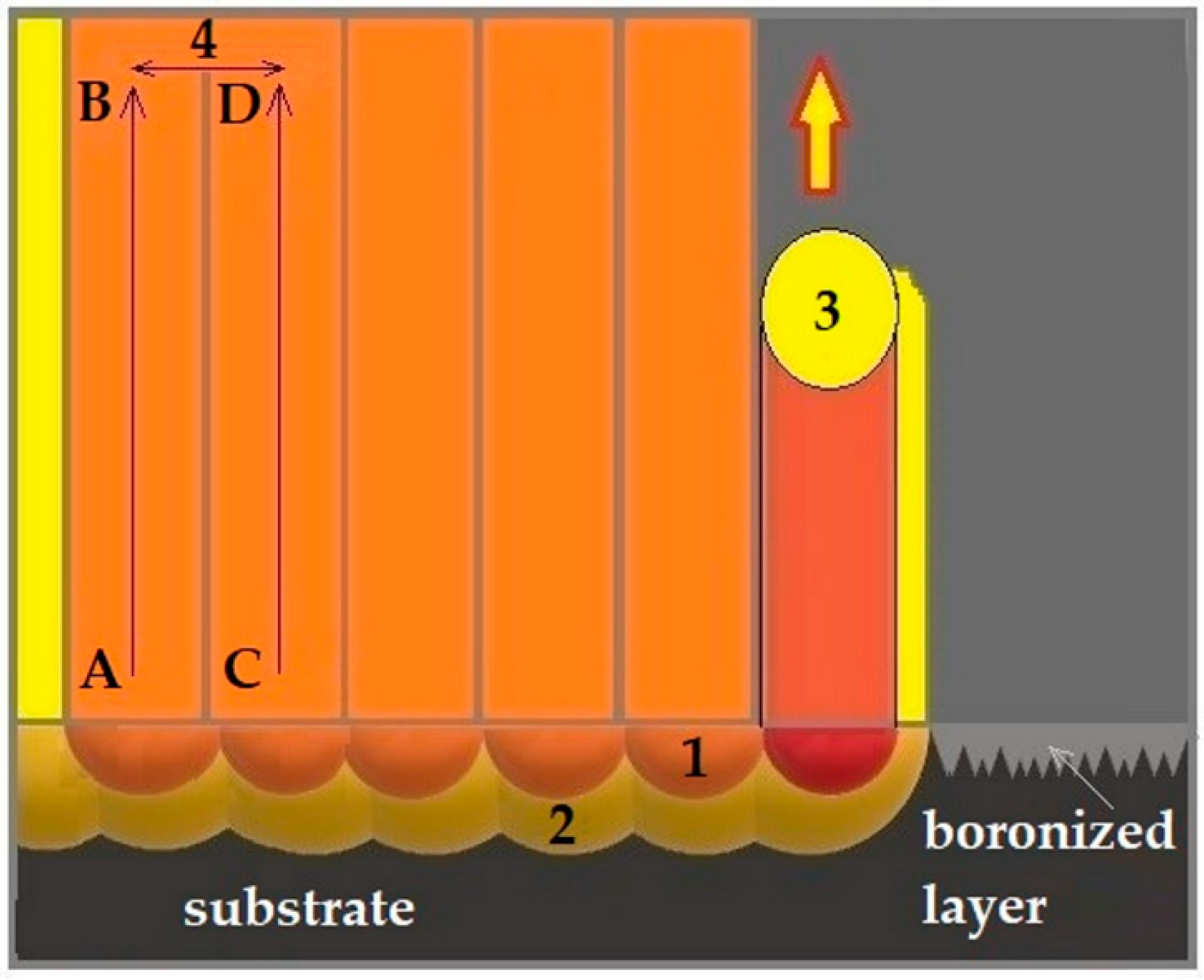




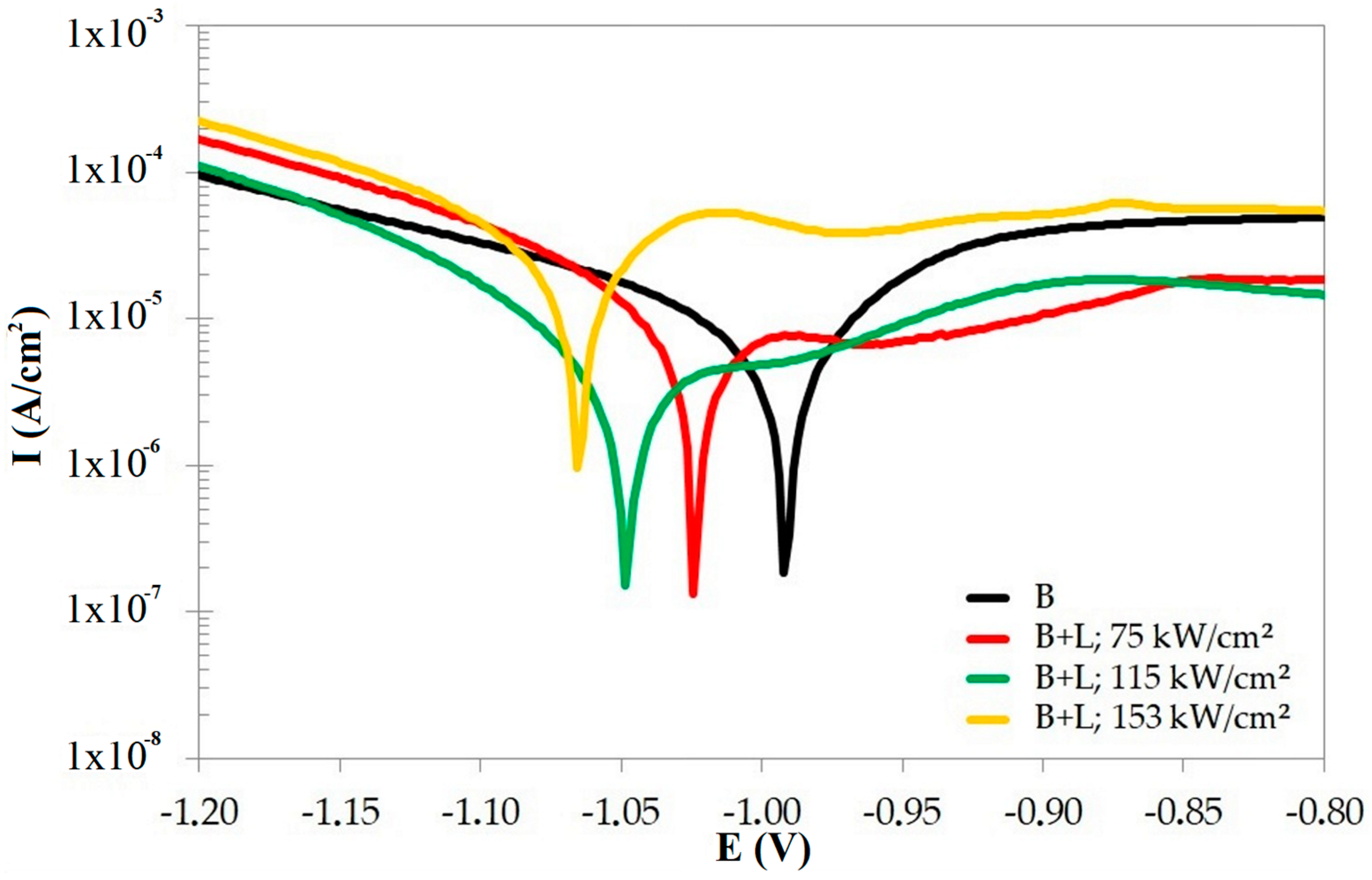
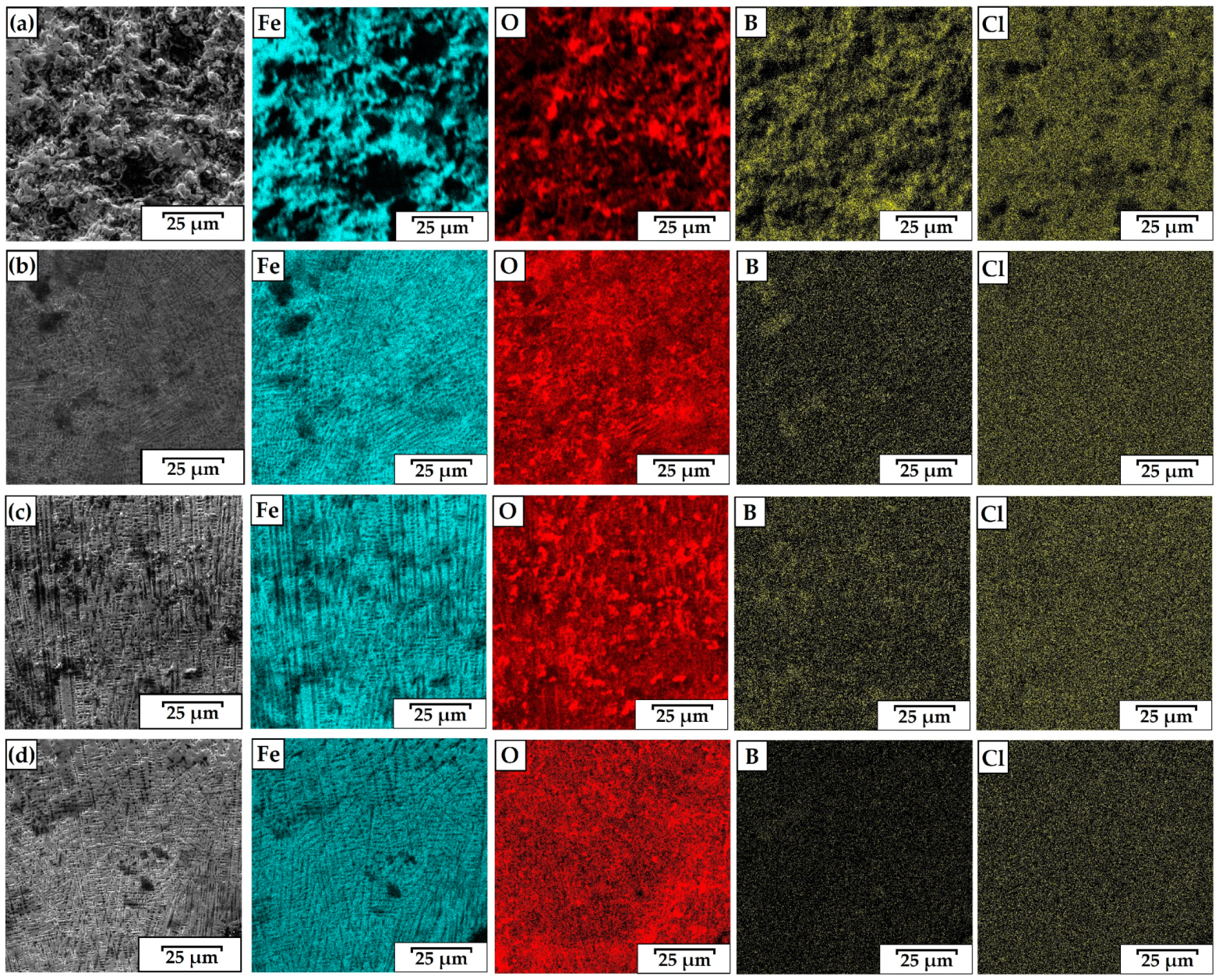
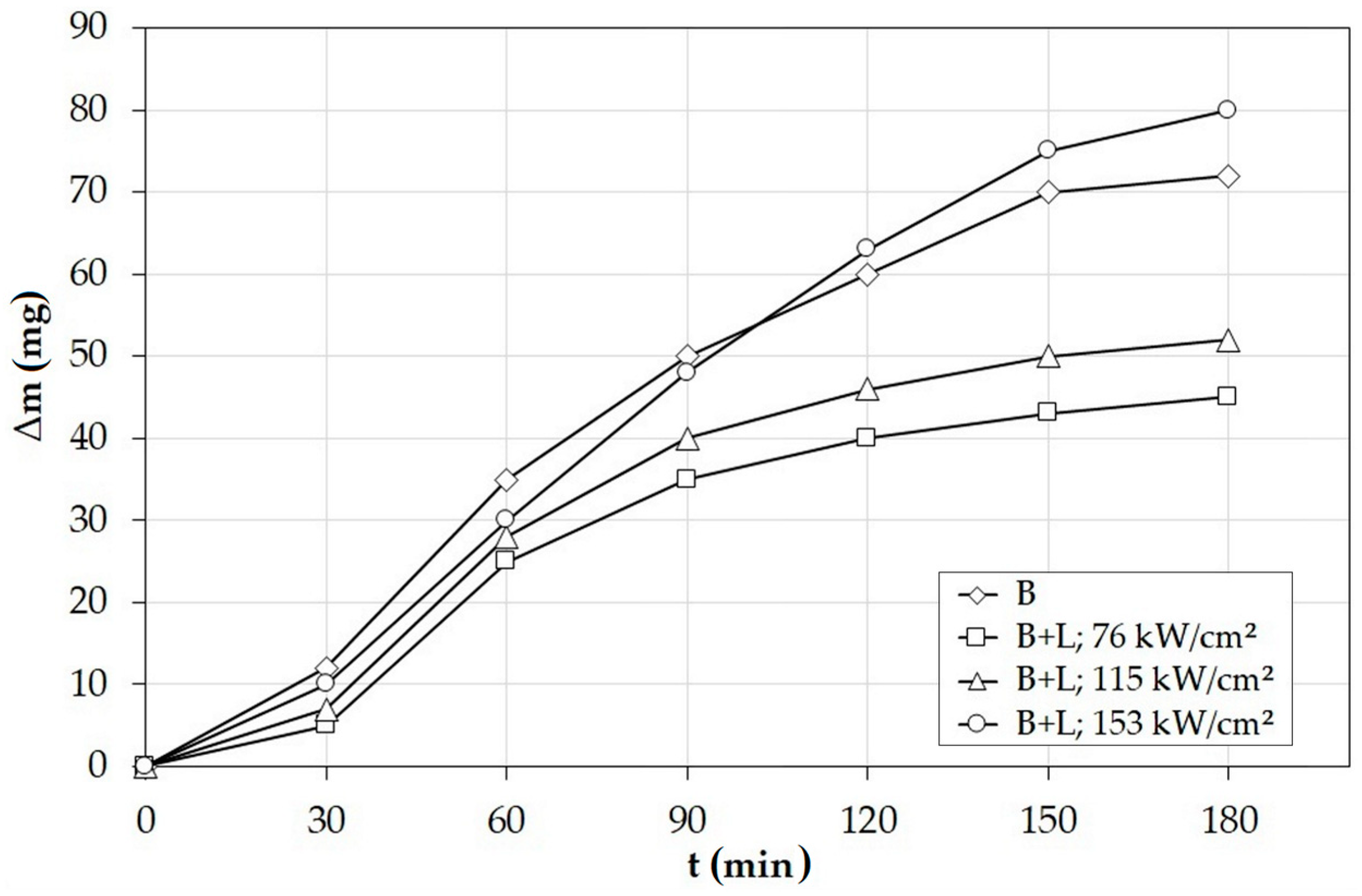
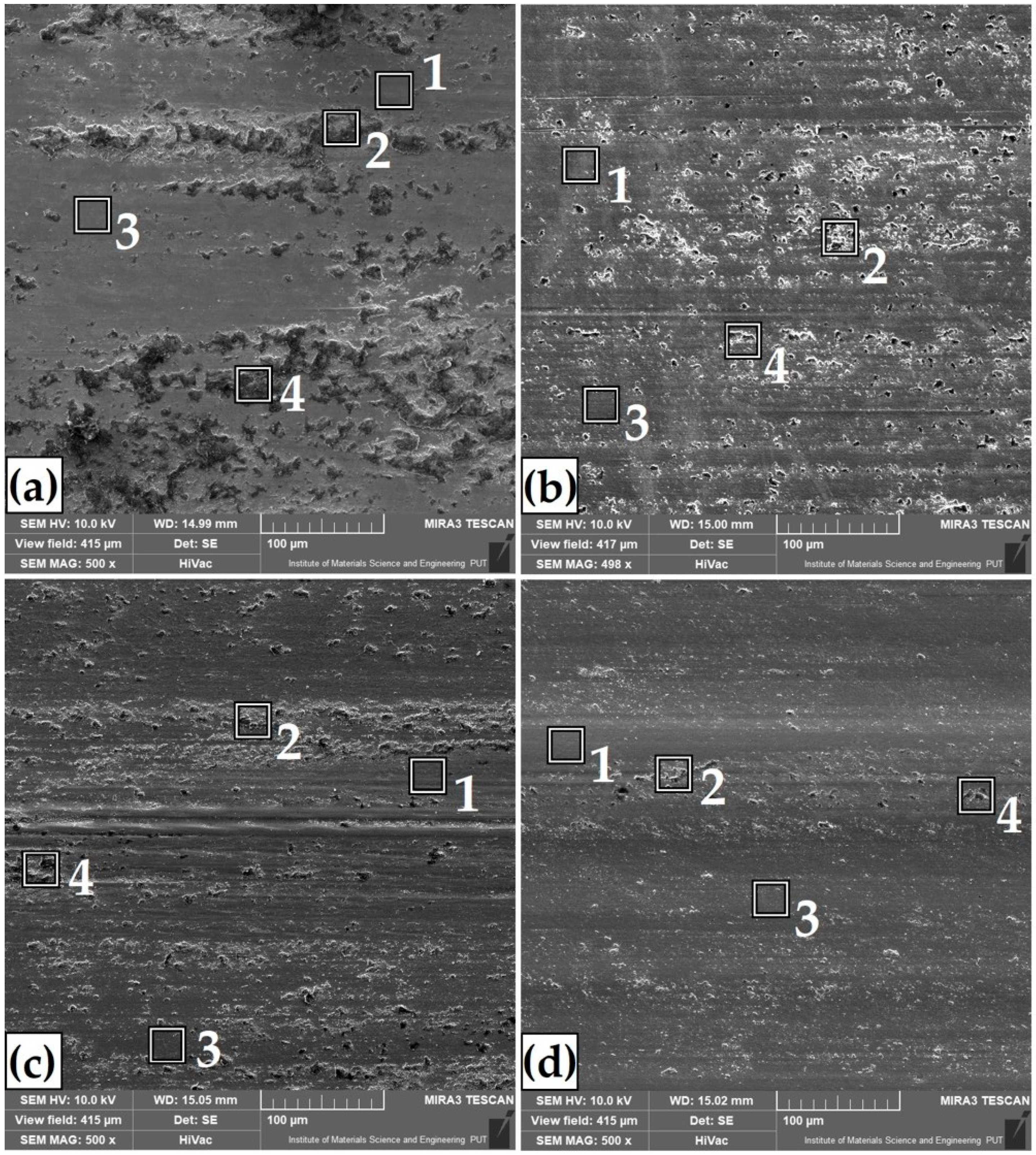
| C | Mn | Si | P | S | Cr |
|---|---|---|---|---|---|
| 0.89 | 0.25 | 0.30 | 0.025 | 0.025 | 0.15 |
| P (W) | q (kW/cm2) | v (mm/s) | d (mm) | Et (s) | F (J/mm2) |
|---|---|---|---|---|---|
| 600 | 76 | 50 | 1 | 0.02 | 15 |
| 900 | 115 | 50 | 1 | 0.02 | 23 |
| 1200 | 153 | 50 | 1 | 0.02 | 31 |
| Process | Zone | Measurement Results (µm) | |
|---|---|---|---|
| Average | σ | ||
| B | T | 105 | 2.34 |
| B + L 76 kW/cm2 | MZ | 197 | 6.48 |
| HAZ | 104 | 4.67 | |
| T | 301 | 6.55 | |
| B + L 115 kW/cm2 | MZ | 421 | 8.55 |
| HAZ | 136 | 7.93 | |
| T | 559 | 13.93 | |
| B + L 153 kW/cm2 | MZ | 555 | 5.52 |
| HAZ | 225 | 7.65 | |
| T | 780 | 8.39 | |
| Process | No | Fe | C | B |
|---|---|---|---|---|
| B | 1 | 87.1 | 3.6 | 9.3 |
| 2 | 90.1 | 3.6 | 6.3 | |
| 3 | 88.5 | 2.6 | 8.9 | |
| 4 | 88.5 | 2.8 | 8.7 | |
| 5 | 89.0 | 3.4 | 7.6 | |
| 6 | 94.5 | 5.5 | 0.0 | |
| B + L 76 kW/cm2 | 1 | 86.0 | 9.2 | 6.7 |
| 2 | 85.9 | 11.2 | 6.5 | |
| 3 | 85.0 | 8.7 | 6.2 | |
| 4 | 85.0 | 9.2 | 5.8 | |
| 5 | 91.6 | 8.4 | 0.0 | |
| B + L 115 kW/cm2 | 1 | 89.9 | 6.6 | 3.5 |
| 2 | 89.3. | 7.2 | 3.5 | |
| 3 | 89.8 | 6.5 | 3.7 | |
| 4 | 88.9 | 7.7 | 3.4 | |
| 5 | 88.1 | 11.1 | 0.2 | |
| B + L 153 kW/cm2 | 1 | 88.6 | 8.7 | 2.7 |
| 2 | 88.8 | 8.9 | 2.2 | |
| 3 | 88.2 | 9.0 | 2.8 | |
| 4 | 88.6 | 9.8 | 1.6 | |
| 5 | 89.0 | 9.8 | 1.2 | |
| 6 | 89.5 | 9.9 | 0.6 |
| Process | Current Icorr (A·cm2) | Potential Ecorr (V) |
|---|---|---|
| B | 3.50 × 10−6 | −9.92 × 10−1 |
| B + L (76 kW/cm2) | 2.91 × 10−6 | −1.02 × 10+0 |
| B + L (115 kW/cm2) | 1.77 × 10−6 | −1.05 × 10+0 |
| B + L (153 kW/cm2) | 1.04 × 10−5 | −1.07 × 10+0 |
| Name of Process | No | Fe | B | C | O |
|---|---|---|---|---|---|
| B | 1 | 88.3 | 9.0 | 1.8 | 0.9 |
| 2 | 57.3 | 0.9 | 12.5 | 29.3 | |
| 3 | 88.7 | 7.9 | 2.0 | 1.4 | |
| 4 | 58.7 | 1.4 | 11.5 | 28.4 | |
| B + L 76 kW/cm2 | 1 | 95.4 | 1.3 | 2.7 | 0.6 |
| 2 | 76.0 | 1.3 | 7.9 | 14.9 | |
| 3 | 95.3 | 1.1 | 2.9 | 0.8 | |
| 4 | 61.8 | 0.9 | 10.7 | 26.7 | |
| B + L 115 kW/cm2 | 1 | 96.0 | 1.4 | 2.0 | 0.6 |
| 2 | 72.8 | 0.2 | 4.2 | 22.8 | |
| 3 | 95.2 | 1.2 | 2.7 | 0.9 | |
| 4 | 93.1 | 0.7 | 2.2 | 4.0 | |
| B + L 153 kW/cm2 | 1 | 94.0 | 2.3 | 2.6 | 1.1 |
| 2 | 88.2 | 1.5 | 3.6 | 6.7 | |
| 3 | 93.9 | 0.8 | 2.5 | 2.8 | |
| 4 | 78.7 | 1.1 | 6.3 | 14.0 |
Publisher’s Note: MDPI stays neutral with regard to jurisdictional claims in published maps and institutional affiliations. |
© 2020 by the author. Licensee MDPI, Basel, Switzerland. This article is an open access article distributed under the terms and conditions of the Creative Commons Attribution (CC BY) license (http://creativecommons.org/licenses/by/4.0/).
Share and Cite
Bartkowska, A. Production and Properties of FeB-Fe2B-Fe3(B,C) Surface Layers Formed on Tool Steel Using Combination of Diffusion and Laser Processing. Coatings 2020, 10, 1130. https://doi.org/10.3390/coatings10111130
Bartkowska A. Production and Properties of FeB-Fe2B-Fe3(B,C) Surface Layers Formed on Tool Steel Using Combination of Diffusion and Laser Processing. Coatings. 2020; 10(11):1130. https://doi.org/10.3390/coatings10111130
Chicago/Turabian StyleBartkowska, Aneta. 2020. "Production and Properties of FeB-Fe2B-Fe3(B,C) Surface Layers Formed on Tool Steel Using Combination of Diffusion and Laser Processing" Coatings 10, no. 11: 1130. https://doi.org/10.3390/coatings10111130





